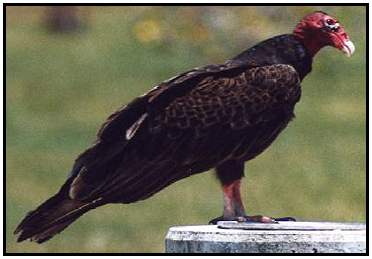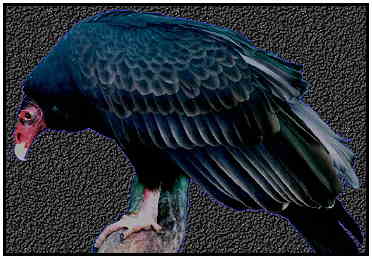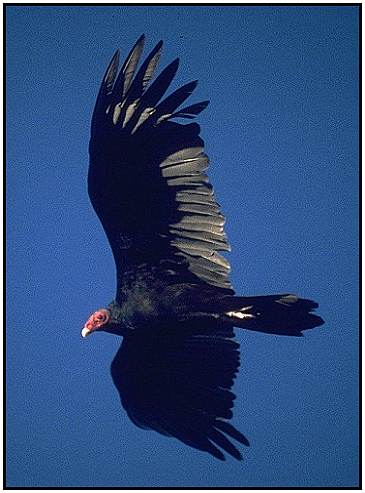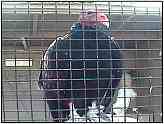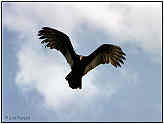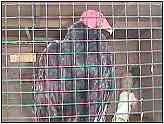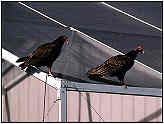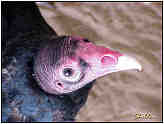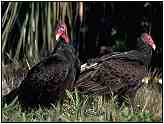TurkeyOrder: Falconiformes. Family: Cathartidae. (New World vulture). Scientific Name: Cathartes aura. Common Names: Turkey Vulture. (Sometimes incorrectly called the Turkey Buzzard. 'Buzzards' are properly broad-winged hawks).
Turkey VultureConservation Status: Common. The most abundant of all the New World vulture species. Extensively trapped and destroyed in many parts of their range due to the mistaken belief that they carry anthrax and other diseases. Have vanished from some areas where they were previously seen in large numbers. This is thought to be due to stricter laws on burying dead cattle. With no food the Turkey Vulture has been starved out of these areas. Considered pests on some Peruvian islands where they steal eggs and young birds. Rescue & Recovery: In most of the United States they are protected by law largely because their scavenging habits provide such a benefit in removing possible sources of infection. Geographical Range: Found from the southern U.S. to central Patagonia. (North and South America). Now starting to appear in Canada. Most of the birds found in the northern part of their range regularly migrate to the south. Habitat: A wide range of habitats. Plains, desert, forests, even urban situations. Turkey JohnsonPhysical Characteristics: Wingspan of some 26 centimetres and a distinctive appearance when in flight which comes from its long V-shape wings, long tail and rocking motion. The plumage is almost black, with a slightly iridescent appearance, especially on the wings, which are silvery. In proportion to the body mass this bird's head is very small. Genetic examination has demonstrated that the Turkey Vulture is more closely related to storks than to the vultures of Africa and Eurasia. They have an internal thermostat which aids in reducing energy loss overnight and in the morning they use the sun to reheat cooled organs. Once they take flight, their very broad wings and light body mean they can soar for long periods with an absolute minimum of effort. Their most interesting development is related to their sense of smell, something that is so finely tuned as to be almost unique among birds. In the United States Turkey Vultures are used to aid engineers in locating gas leaks; the engineers pump strong-smelling gases through pipes and note where the vultures gather. The Turkey Vulture gets its name from the resemblance it carries to the male wild turkey. Food: The Turkey Vulture is quite dependent upon its sense of smell to help locate food and the area of their brain controlling sense of smell is three times larger than of the Black Vulture. Research has shown they can locate a carcass within only twenty-four hours of death. These birds often go for days without feeding and when they do eat are very flexible about their meals, attacking even the tiniest carcass, rotten fruit, vegetables and even sea lion excrement. Have been known to kill young herons, ibis and even newborn pigs. Like the Black Vulture, this bird patrols roads searching for road kill; they have been so frequently seen doing this that dead animals on roads are now sometimes referred to as 'TV dinners', where TV stands, not for television, but for Turkey Vulture. Turkey VultureThese birds will devour the most putrid of meat and have a natural immunity the toxins which might kill any other creature. Botulism has no effect on the Turkey Vulture at all. Droppings are happily deposited upon the legs of the vulture as these contain an antiseptic coating which then protects the birds legs from contracting infection through the prey. Bald heads are also vulnerable to various bacteria, however the sun kills these off before any harm occurs. However, Turkey Vultures often do become ill and are very susceptible to stress. Food is frequently regurgitated, either to reduce bodyweight and allow take-off in the event of an emergency, or as a form of defence. It is said that skunks and the contents of a Turkey Vultures stomach have much in common. Reproduction: The nesting season for this bird occurs during the warmer weather and the female lays two, occasionally three, eggs in a cave or hollow log. Both parents share in the six week incubation and the are of the young, until they leave the nest at about ten weeks. The young are born with down feathers covering their heads and these are lost when the adult plumage grows in. Thumbnails (Click For Full-Size Image):
|

